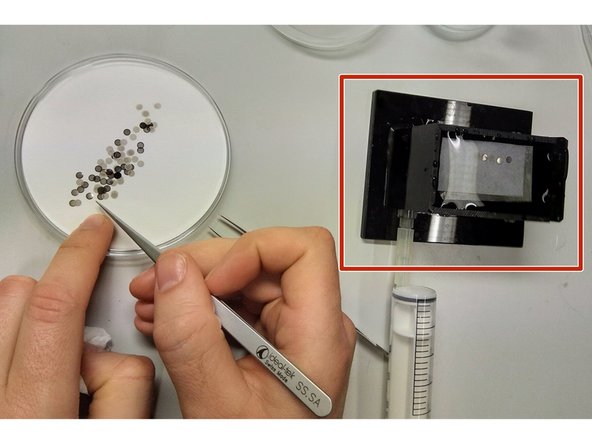Introduction
Thin carbon films on electron microscopy grids are used for high resolution imaging of negative staining applications. Ultraflat carbon films are produced using cleaved mica and electron beam evaporation coating.
-
-
Split mica sheets using tweezers or scalpel just before coating.
-
Coat the freshly cleaved surfaces with 2 to 5 nm of carbon, e.g. using an MED 020 electron beam evaporator.
-
Place the coated mica on top of several layers of filter paper in a glass petri dish.
-
Wet filter paper with water. Cover the petri dish and put in an oven at 60°C for 30 min.
-
-
-
Use dedicated container tool. For better visibility a transparent tool is shown here.
-
Attach empty syringe to the connection tube at the container.
-
Place a fine meshed metal grid on the support bars.
-
-
-
Add a filter paper on top and fill the container completely with distilled/nanopure water.
-
Use nickel or copper grids 300 or 400 mesh.
-
Place the grids on top of the filter paper. Avoid air bubbles attaching to the grids upon dipping under the water. You may render grids hydrophilic first by glow discharging.
-
-
-
Pick up the coated mica from the oven and immerse it slowly at an angle of 45° into the water bath. The carbon layer will float off. Note: Do not retract mica. Release mica into the container when carbon layer has floated off completely.
-
Remove water using the syringe attached to the container at the bottom. The carbon layer is lowered on the grids on the filter paper. Note: You still can arrange/position the carbon layer carefully with tweezers to cover all grids while lowering water level.
-
-
-
Remove filter paper with grids and place on filter paper in a petri dish for drying.
-
Fine meshed metal grid.
-
Filter paper.
-
Carbon layer on grids and filter paper.
-
Cancel: I did not complete this guide.
One other person completed this guide.







